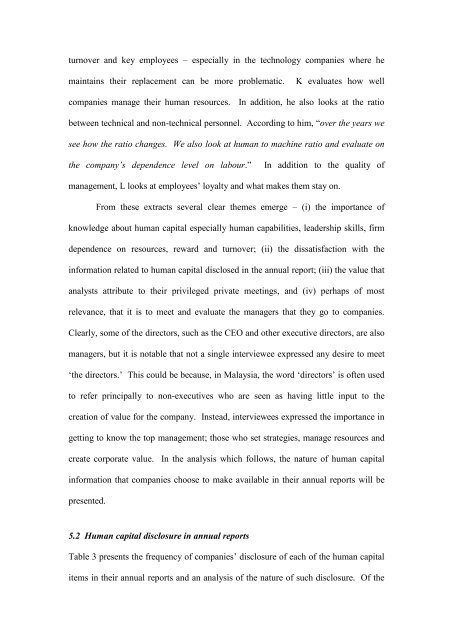Huang, C. , Luther, R. , Tayles, M. and Haniffa, R. - UWE Research ...
Huang, C. , Luther, R. , Tayles, M. and Haniffa, R. - UWE Research ...
Huang, C. , Luther, R. , Tayles, M. and Haniffa, R. - UWE Research ...
You also want an ePaper? Increase the reach of your titles
YUMPU automatically turns print PDFs into web optimized ePapers that Google loves.
turnover <strong>and</strong> key employees – especially in the technology companies where he<br />
maintains their replacement can be more problematic. K evaluates how well<br />
companies manage their human resources. In addition, he also looks at the ratio<br />
between technical <strong>and</strong> non-technical personnel. According to him, “over the years we<br />
see how the ratio changes. We also look at human to machine ratio <strong>and</strong> evaluate on<br />
the company‟s dependence level on labour.” In addition to the quality of<br />
management, L looks at employees‟ loyalty <strong>and</strong> what makes them stay on.<br />
From these extracts several clear themes emerge – (i) the importance of<br />
knowledge about human capital especially human capabilities, leadership skills, firm<br />
dependence on resources, reward <strong>and</strong> turnover; (ii) the dissatisfaction with the<br />
information related to human capital disclosed in the annual report; (iii) the value that<br />
analysts attribute to their privileged private meetings, <strong>and</strong> (iv) perhaps of most<br />
relevance, that it is to meet <strong>and</strong> evaluate the managers that they go to companies.<br />
Clearly, some of the directors, such as the CEO <strong>and</strong> other executive directors, are also<br />
managers, but it is notable that not a single interviewee expressed any desire to meet<br />
„the directors.‟ This could be because, in Malaysia, the word „directors‟ is often used<br />
to refer principally to non-executives who are seen as having little input to the<br />
creation of value for the company. Instead, interviewees expressed the importance in<br />
getting to know the top management; those who set strategies, manage resources <strong>and</strong><br />
create corporate value. In the analysis which follows, the nature of human capital<br />
information that companies choose to make available in their annual reports will be<br />
presented.<br />
5.2 Human capital disclosure in annual reports<br />
Table 3 presents the frequency of companies‟ disclosure of each of the human capital<br />
items in their annual reports <strong>and</strong> an analysis of the nature of such disclosure. Of the

















